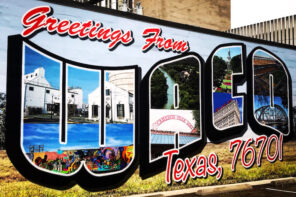Anyone who saw last year’s standout documentary, Jesse Moss’ The Overnighters, probably noted a brief, sober coda to the story: one of the film’s subjects, Keith Graves, was recently convicted of sex-trafficking and drug possession in a court in North Dakota. In the film, Graves’ presence as a guest in the house of Williston’s Lutheran pastor is a crisis point in a story that tests the limits of a fundamental value: love of neighbor. But the film also offers a powerful meditation on the social costs of environmental destruction, and, in this case, religion’s unexpected role in the unfurling of a many-limbed tragedy.
The oil boom, driving a massive transformation of western North Dakota, makes the news for many reasons. But almost none of them are, in any obvious way, religious. Most recently there’s been talk of how regulation policies for shipping North Dakota crude may have contributed to the derailment and explosion of a train in West Virginia. What’s happening on the oil patch is, in essence, an environmental crisis. So it would make sense if the bulk of oil boom news were related to these metamorphoses in the land, and the landscape. But nothing alters the natural world without changing life for the creatures on it. And so it has actually been the case that most oil boom news is related to its human costs: the housing crisis (driven by an influx of new labor), or crime (sex and drugs ) None of these things, however, demarcate the oil boom as a phenomenon with any real religious stakes.
It is for this reason, perhaps, that The Overnighters, seems like such an odd story. The central character is Jay Reinke, pastor of a Lutheran church in Williston, North Dakota—a city in the heart of the oil boom. Called to be a good neighbor to the growing number of new residents coming to Williston for work, and finding themselves without a place to sleep, Reinke and his family begin to open up the church as a home space to those in need of one. These newcomers are The Overnighters. This is done much to the chagrin of the church’s neighbors, and many residents of the town.
Significant narrative tensions in the film are driven by Reinke’s unwelcome acts of Christian charity. But as Moss recently confessed to Pamela Cohn, in an interview for BOMB Magazine, as a director he struggled with the fact that the setting for his film was quickly becoming a church. “It wasn’t where I expected to find myself,” Moss said, “and it clashed with what I imagined a film about the North Dakota oil boom should be.”
Religion in American public life is sucked, more often than not, into the vacuum of highly politicized issues. It is as though religion is a kind of explosive substance that we can either fight to extend deeper into politics—or we fight more vociferously to extricate it from the political. Religion is either the poison or the cure.
If religion is discussed tangentially with environmental crises it tends to fall into this sort of dynamic. Religious groups are either blamed for their dismissal of climate change, and their apathy toward the environment (a position developed most succinctly, perhaps, by the comedian Louis CK). Or they are held up as potential sources for, or models of, a more sustainable environmental ethic.
What’s most interesting, to me, about this film is that it shifts the interface between religion and the environment, entirely. In The Overnighters religion is neither poison nor cure. Instead, the church becomes a filter, of sorts: a lens through which we see, with a new kind of clarity and a much closer view, the social havoc that is being driven by a major environmental change; a lens through which we see an alteration in the local environment driving changes in the local economy, driving social crises, and driving something along the order of spiritual crisis as well.
To be fair, this church-as-lens perspective seems mostly to have emerged as a matter of convenience. Jay Reinke had opened up his church to itinerants moving through the town of Williston, looking for work and drawn by the lure of oil. Jesse Moss, the filmmaker, was himself one of those itinerants in a sense: he was an outsider who’d been drawn toward a good story, gleaming at the surface of the oil patch. Reinke’s church proved a public space where Moss could park his camera, and watch the action unfold. The church looks like a lens, or a filter, because that’s what it was: a space where the local issues unfolded for the filmmaker’s lens in a more intimate setting.
Neither is this film, in any overt sense, about the environment per se. Of course, the camera pans across a prairie, dotted with horizontal drills. The environmental context is not irrelevant. But this is not an anti-fracking diatribe, and there is little reference to the actual impact of oil extraction, beyond the periodic laments of Williston residents and churchgoers about what’s happening to their prairie—the sorrow they express, in spurts, about its destruction.
This film is poignant because it offers a story, a very human story, rather than an agenda. Promotional materials for the film describe it as a modern-day “Grapes of Wrath”, and the comparison is apt. Like Steinbeck’s story, Moss’s is also a kind of epic, even tragic, tale set against the backdrop of economic hardship and industry callousness. But the powerful storytelling, the tale of an oil boom on a human scale, illuminates aspects of these vestiges we associate with the religious life—the social space of the church, the Bible—and brings them into a curious kind of conversation with their environmental context.
One of the film’s subjects, for instance, reflecting on his personal vendetta against Reinke uses a biblical passage to muse—quasi-prophetically—that the pastor will get his just desserts. “I’ll give him a scripture verse,” the subject says with some vitriol, mocking Reinke’s public face as a pastor who inevitably takes shelter beneath this text: “you sow the wind, you reap the whirlwind.”
The scripture verse he cites—a passage from the Book of Hosea, one of the minor prophets—is clearly a metaphor in both this reference and its textual manifestation. What would it even mean to apply agricultural techniques to something as completely undomesticated as the wind? But the fact that this verse plays with the natural world as a kind of trope is neither irrelevant nor purely incidental.
Contemporary biblical commentators on the Book of Hosea have set the prophet against his social and historical backdrop, surrounded by the fertility cults of ancient Canaanite religions. The term “fertility cult” often describes traditions that celebrate the cyclical nature of the passing seasons, that locate worship at the potent interface between the human and the natural world. A rich set of metaphorical references in the Book of Hosea pulls from what would probably have been significant and heady forces in a fertility cult: images that make reference to the natural world. For the monotheist Hosea, of course, forces of the natural world—such as the wind—are not divine. In a sense, then, the prophet uses these images of nature to scold those who might seek to worship it, over the creator. But the Hebrew term he uses for “wind” in this context is ruah: a term that’s also, often, used to refer to the divine spirit itself.
More likely than not, ruah does not have a double valence here—it probably just means “wind.” But the suggestive ambiguity around this complex and multivalent term underscores the convoluted fate of a biblical theology that want to illuminate a God who acts in history—and its stage in the natural world—but is not, really, of it. This kind of theology is always sticking to nature, getting stuck in it. Hosea might merely be borrowing images of a divinely powerful nature, in order to shroud his own god in some of these trappings. He might merely be using these images as a kind of rhetorical lure. But the consequence of this blending is inevitably a kind of uncertainty. Where does divine power stop, and the wind itself begin? Part of the poetry, the vitality, of the text is this very ambiguity.
In spite of the fact that this passage is merely a passing reference in the film, one tied to a personal vendetta and nothing more, the poetry of the film itself is such that these weird little moments do carry a kind of power and poetic significance. To be fair, it’s quite possible that this image of an angry wind—one that’s predicted to become even angrier—may have stuck out for me merely because I know how the wind can be in North Dakota. In my first year here at the eastern edge of a prairie state, I’ve become acquainted with the wind as a kind of personality—even an adversary. The trees, here, are sparse and there’s nothing to stop the wind from ripping into everything. In the good weather, it whips my hair around as if it’s pulling at it. In cold weather, it’s the thing that makes -8 degrees Fahrenheit “feel like” -28, to use the language of the weather reports. In that kind of weather, it can burn you like the sun. The wind, here, is a potent metaphor.
I live on the opposite side of the state from the oil boom itself. But, still, I’m often surprised by how little the issues on the other side of the state seem to be affecting things here. I hear students talk about transformations in their hometowns, of course. And I’ve heard from people here that some workers out west have been sending their families to live on the eastern side of the state, as there’s more available housing. I often wonder how many of the people moving into the new apartment units along the highway—right next to my faculty housing unit on the edge of campus, which is basically the edge of town—have family on the oil patch. I’ve also wondered if oil money is tied to the newly constructed financial advising firms that I’ve noticed around town. The Overnighters gave me a glimpse into this world that’s very close, and yet very distant, that was far more moving and far more intimate than any of the other documentaries I’ve watched or news stories I’ve read.
The film has also left me far more haunted by questions about what’s really happening for people who are living in the wake of this social and environmental transformation—and what will happen in the coming years. Without spoiling the very end, for those of you who do intend to see it, I will just say it seems that Reinke himself is ultimately visited by the whirlwind. There’s no justice in this end, only a kind of resounding sadness—the feeling that worlds have been unmade in the wake of these social and environmental transformations. In this sense, then, the film feels—to borrow a genre term from the biblical context—much like a lament. It seems like a dirge for things that have been lost, that are being lost. A kind of jeremiad for the lives being transformed while, across the country, we burn the midnight oil—their midnight oil.





